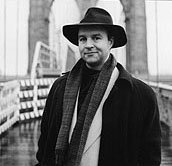S & H Concert Review
Mahler, Symphony No.10; Kensington Symphony Orchestra, Russell Keable, St. John’s Smith Square, 15 March 2003 (AR)
This performance of Mahler’s unfinished ‘Tenth’ Symphony under Russell Keable, and the Kensington Symphony Orchestra, used the performing version of Mahler's draft, prepared by Deryck Cooke, with, according to the conductor, some differences:‘I made a number of additions and deletions drawing partially on Joe Wheeler and Remo Mazzetti versions; and in a couple of places (which I find embarrassingly thin in the Cooke realisation) composing my own Mahler pastiche.
Most conductors tinker a bit (with all four of the different versions, even the highly interventionist Clinton Carpenter edition) and I found great inspiration in the convincing retouches of Kurt Sanderling (in his 1979 Berlin Symphony Orchestra recording)’ (email to author, 18th March 2003)
In 1960, the year marking Mahler’s centenary, Cooke prepared a broadcast on the BBC Third Programme on the 19th of December of the first, third and fifth movements in full, with fragments taken from the two Scherzi. Later Alma Mahler listened to a tape of the 1960 broadcast and Cooke related that she ‘was moved to tears by the music and confessed that she had not realised ‘how much Mahler there was in it.’ After listening to the tape Alma Mahler wrote to Cooke in May 1963: ‘I was so moved by this performance that I immediately asked Mr. Byrns to play the work a second time. I then realised that the time had come when I must reconsider my previous decision not to permit the performance of this work. I have decided, once and for all, to give you full permission to go ahead with performances in any part of the world…’ After Alma died her daughter discovered another 44 pages of sketches and short-score which Cooke was able to insert in time for Goldschmidt’s first complete performance at the Proms, with the LSO, on the 13th August 1964.
The Kensington Symphony Orchestra, founded in 1956 by Leslie Head to provide students and amateurs in London with the possibility to take part in orchestral concerts, has high standards of playing and their performance of this work was certainly on a par with established, professional London symphony orchestras. Composer-lecturer-conductor Russell Keable has a reputation for being a champion of Erich Korngold’s music, having given a concert version of Korngold’s opera Violanta (composed when Korngold was only 17) at the QEH, as well as the British premier of Die tote Stadt in 1995-1996. On this showing he is equally sympathetic in Mahler.
The KSO produced a stunning ‘Mahler sound’ - raucous, rugged, grainy and angular, giving this fragmented torso of a score great weight. I heard Simon Rattle conduct a different kind of performance of the Mahler ‘Tenth’ with the Philharmonia Orchestra at a 1980s Prom concert - smooth, streamlined and homogenised, the antithesis of Keable’s poignant performance, which teetered on the brink of nervous hysteria. Keable’s account was superior in its penetration of Mahlerian anxiety, something not always achieved in recordings of the work.
The first movement, Adagio: Andante – Adagio (fully scored by Mahler himself), unfolded with grace, with Keable and his orchestra in total rapport: his beat was clear and razor sharp and his tempi were perfectly judged: the music flowed organically, without manneristic gear-shifts, seeing the Adagio as an arch-like structure, and producing intimate chamber-like textures. The movement’s central climax burst into flame with its piercing long held trumpet note. This shrieking sound was delivered with a menacing intensity rarely experienced: it was pure terror, life staring death in the face. The second movement, Scherzo: Schnelle Viertel, was performed with great swagger and rhythmic lilt with the horns especially brazen and incisive.
The Allegreto Moderatto is the pivotal point of the symphony - lodged between two scherzi which, in turn, are flanked by two large slow movements. Mahler originally titled this movement Purgatorio or Inferno (but later deleted these titles) and the composer actually scored half of it. Under Keable it certainly sounded echt-Mahler, reminding one of the sinister Scherzo of Mahler’s 7th Symphony. There was some very expressive and pointed woodwind playing with conductor in complete command of the angular wild expressionism inherent in this dark music.
The Scherzo Allegro pesante, Nicht zu schnell, veered towards explosive hysteria with the conductor encouraging manic playing, totally in keeping with the ethos of this demonic music: even when the full orchestra were playing one could hear all the intricate woodwind passages. The Finale: Einleitung, Langsam, schwer – Allegro moderato – Andante, opened with dry, ominous ‘death knell’ hammer blow followed by threatening sounds from bass tuba and horns, executed with a menacing assurance.
The mood slowly switched to a melancholic swan song of resignation in the form of a sublimely phrased flute solo. As the movement progressed, the strings took on a serene sound, becoming darker and grainier than before; this was especially so with the ‘cellos and double basses which had a rugged darkness of tone. As the music progressed the strings became even more tenebrous, slowly melting into nothingness.
Throughout this penetrating and powerful performance, Keable had the KSO and audience transfixed: his conducting was hypnotic, his presence magnetic.
This massive work, demanding huge forces, clearly demonstrated the superb SJSS crystalline acoustic, which allowed the intricately layered orchestral textures to shine through with great clarity and perfect audibility, even during the numerous tutti passages.
Alex Russell
To become a friend of the orchestra you can e-mail them at: kensington.symphony@dial.pipex.com. And for further information contact their website at: www.kso.org.uk

 Return to:
Return to: